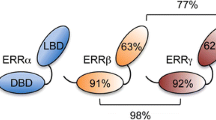Abstract
This issue of the Journal of Cell Communication and Cell Signaling on hormetic mechanisms represents an important step in the evolution of the hormesis dose response concept. Since its modern resurgence in the late 1970s the widespread occurrence of hormesis has been in search of its underlying mechanisms. The present integrative set of papers builds upon significant recent advances in the elucidation of hormetic mechanisms and provides the reader with a deep and extensive view of the concept of hormesis from a broad range of researcher perspectives and in many biomedical applications.

Similar content being viewed by others
References
Calabrese EJ (2005) Historical blunders: how toxicology got the dose-response relationship half right. Cell Mol Biol 51(7):643–654
Calabrese EJ (2008) Hormesis: why it is important to toxicology and toxicologists. Environ Toxicol Chem 27(7):1451–1474
Calabrese EJ (2013) Hormesis mechanisms. Crit Rev Toxicol 43(7):580–606
Calabrese EJ, Baldwin LA (2000a) Chemical hormesis: its historical foundations as a biological hypothesis. Hum Exp Toxicol 19(1):2–31
Calabrese EJ, Baldwin LA (2000b) The marginalization of hormesis. Hum Exp Toxicol 19(1):32–40
Calabrese EJ, Baldwin LA (2000c) Radiation hormesis: its historical foundations as a biological hypothesis. Hum Exp Toxicol 19(1):41–75
Calabrese EJ, Baldwin LA (2000d) Radiation hormesis: the demise of a legitimate hypothesis. Hum Exp Toxicol 19(1):76–84
Calabrese EJ, Baldwin LA (2000e) Tales of two similar hypotheses: the rise and fall of chemical and radiation hormesis. Hum Exp Toxicol 19(1):85–97
Calabrese EJ, Baldwin LA (2002) Defining hormesis. Hum Exp Toxicol 21(2):91–97
Calabrese EJ, Baldwin LA (2003) The hormetic dose-response model is more common than the threshold model in toxicology. Toxicol Sci 71(2):246–250
Calabrese EJ, Blain R (2005) The occurrence of hormetic dose responses in the toxicological literature, the hormesis database: an overview. Toxicol Appl Pharmacol 202(3):289–301
Calabrese EJ, Blain RB (2009) Hormesis and plant biology. Environ Poll 157(1):42–48
Calabrese EJ, Blain RB (2011) The hormesis database: the occurrence of hormetic dose responses in the toxicological literature. Reg Toxicol Pharmacol 61(1):73–81
Crump T (2003) Contemporary medicine as presented by its practitioners themselves. Leipzig 1923:217–250. Hugo Schulz, NIH Library Translation (NIH-98-134). Nonlinear Biol Toxicol Med 1:295–318
Luckey TD (1980) Ionizing radiation and hormesis. CRC Press, Boca Raton
Schulz H (1887) Zur Lehre von der Arzneiwirdung. Virchows Arch Pathol Anat Physiol Fur Klin Med 108:423–445
Schulz H (1888) Uber Hefegifte. Pflugers Arch Gesamte Physiol Mensch Tiere 42:517–541
Southam CM, Ehrlich J (1943) Effects of extract of western red-cedar heartwood on certain wood-decaying fungi in culture. Phytopathology 33(6):517–524
Stebbing ARD (1981) Hormesis: stimulation of colony growth in campanularia-flexuosa (hydrozoa) by copper, cadmium and other toxicants. Aquat Toxicol 1(3–4):227–238
Stebbing ARD (1998) A theory for growth hormesis. Mut Res 403(1–2):249–258
Szabadi E (1977) Model of 2 functionally antagonistic receptor populations activated by same agonist. J Theor Biol 69(1):101–112
Acknowledgments
Research activities in the area of dose response have been funded by the United States Air Force and ExxonMobil Foundation over a number of years. However, such funding support has not been used for the present manuscript. The author confirms independence from the sponsors; the content of the article has not been influenced by the sponsors.
Author information
Authors and Affiliations
Corresponding author
Rights and permissions
About this article
Cite this article
Calabrese, E.J. Hormesis: from mainstream to therapy. J. Cell Commun. Signal. 8, 289–291 (2014). https://doi.org/10.1007/s12079-014-0255-5
Received:
Accepted:
Published:
Issue Date:
DOI: https://doi.org/10.1007/s12079-014-0255-5




